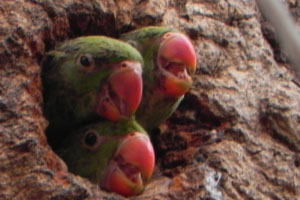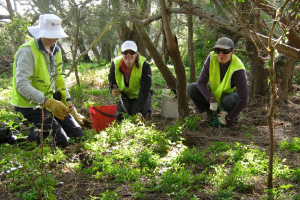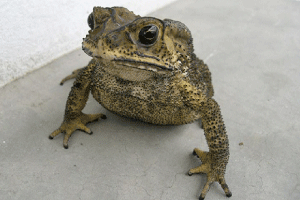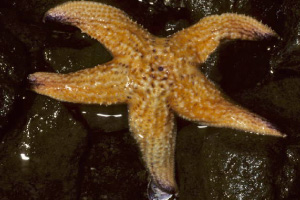
Paying lip-service to prevention
The Invasive Species Council recently put the Victorian government’s risk prevention and risk creator pays policies to the test and found them to be rather meaningless.

The Invasive Species Council recently put the Victorian government’s risk prevention and risk creator pays policies to the test and found them to be rather meaningless.

The Invasive Species Council has long argued for the need for a permitted list approach for plants. Here botanist Bob Parsons explains how the current regulatory system favours the spread of the invasive cushion plants.

The Senate is looking at how to better protect Australia from new invasive species. Use this guide to join our calls for stronger biosecurity to protect our precious natural environmental from yet more invasive species. Late submissions due 22 August.

Gardening Australia wasn’t so bloomin’ marvellous recently when it promoted a serious environmental weed to suburban gardeners.

Decisions on imports are likely to be biased by trade considerations while they are made by the head of the agricultural department.

Our new threatened species commissioner, Gregory Andrews, has already put a foot in the right direction by announcing that tackling feral cats will be high on his agenda.

After the 2013 federal election it seemed like Australia’s national biosecurity bill would disappear into a deep, dark hole never to see the light of day again.

Back on the speaking circuit more than a decade after he wrote Feral Future Tim Low is noticing that audience responses to his new book, Where Song Began, are very different.

The Action Plan for Australian Mammals 2012 has revealed that feral cats, followed by inappropriate fire regimes and the red fox are the greatest threats to Australia’s threatened mammals.

The Australian Senate has set up an inquiry to look into how we can prevent the arrival into Australia of new invasive species impacting on the environment.

In a speech to Parliament, Labor’s Joel Fitzgibbon referred favourably to a presentation by Invasive Species Council CEO, Andrew Cox. He also suggested that there should be a federal Minister for Biosecurity.

Australia’s quarantine system is failing to keep out very damaging environmental invaders and our federal parliament should be seeking to determine why that is.

In August 2013 we released results of our national survey of organisations tackling invasive species. More analysis has revealed some startling results.

In June 2014 a resident of Sunbury in Victoria found an Asian black-spined toad sitting in their dog’s waterbowl. If biosecurity staff find more toads of the same species Victoria could have a major catastrophe on its hands.

The federal Budget 2014-15 delivers nothing of much note for environmental biosecurity, although more than $3 million over four years has been allocated for a review of marine pests.

The Invasive Species Council recently put the Victorian government’s risk prevention and risk creator pays policies to the test and found them to be rather meaningless.

The Invasive Species Council has long argued for the need for a permitted list approach for plants. Here botanist Bob Parsons explains how the current regulatory system favours the spread of the invasive cushion plants.

The Senate is looking at how to better protect Australia from new invasive species. Use this guide to join our calls for stronger biosecurity to protect our precious natural environmental from yet more invasive species. Late submissions due 22 August.

Gardening Australia wasn’t so bloomin’ marvellous recently when it promoted a serious environmental weed to suburban gardeners.

Decisions on imports are likely to be biased by trade considerations while they are made by the head of the agricultural department.

Our new threatened species commissioner, Gregory Andrews, has already put a foot in the right direction by announcing that tackling feral cats will be high on his agenda.

After the 2013 federal election it seemed like Australia’s national biosecurity bill would disappear into a deep, dark hole never to see the light of day again.

Back on the speaking circuit more than a decade after he wrote Feral Future Tim Low is noticing that audience responses to his new book, Where Song Began, are very different.

The Action Plan for Australian Mammals 2012 has revealed that feral cats, followed by inappropriate fire regimes and the red fox are the greatest threats to Australia’s threatened mammals.

The Australian Senate has set up an inquiry to look into how we can prevent the arrival into Australia of new invasive species impacting on the environment.

In a speech to Parliament, Labor’s Joel Fitzgibbon referred favourably to a presentation by Invasive Species Council CEO, Andrew Cox. He also suggested that there should be a federal Minister for Biosecurity.

Australia’s quarantine system is failing to keep out very damaging environmental invaders and our federal parliament should be seeking to determine why that is.

In August 2013 we released results of our national survey of organisations tackling invasive species. More analysis has revealed some startling results.

In June 2014 a resident of Sunbury in Victoria found an Asian black-spined toad sitting in their dog’s waterbowl. If biosecurity staff find more toads of the same species Victoria could have a major catastrophe on its hands.

The federal Budget 2014-15 delivers nothing of much note for environmental biosecurity, although more than $3 million over four years has been allocated for a review of marine pests.

The Invasive Species Council recently put the Victorian government’s risk prevention and risk creator pays policies to the test and found them to be rather meaningless.

The Invasive Species Council has long argued for the need for a permitted list approach for plants. Here botanist Bob Parsons explains how the current regulatory system favours the spread of the invasive cushion plants.

The Senate is looking at how to better protect Australia from new invasive species. Use this guide to join our calls for stronger biosecurity to protect our precious natural environmental from yet more invasive species. Late submissions due 22 August.

Gardening Australia wasn’t so bloomin’ marvellous recently when it promoted a serious environmental weed to suburban gardeners.

Decisions on imports are likely to be biased by trade considerations while they are made by the head of the agricultural department.

Our new threatened species commissioner, Gregory Andrews, has already put a foot in the right direction by announcing that tackling feral cats will be high on his agenda.

After the 2013 federal election it seemed like Australia’s national biosecurity bill would disappear into a deep, dark hole never to see the light of day again.

Back on the speaking circuit more than a decade after he wrote Feral Future Tim Low is noticing that audience responses to his new book, Where Song Began, are very different.

The Action Plan for Australian Mammals 2012 has revealed that feral cats, followed by inappropriate fire regimes and the red fox are the greatest threats to Australia’s threatened mammals.

The Australian Senate has set up an inquiry to look into how we can prevent the arrival into Australia of new invasive species impacting on the environment.

In a speech to Parliament, Labor’s Joel Fitzgibbon referred favourably to a presentation by Invasive Species Council CEO, Andrew Cox. He also suggested that there should be a federal Minister for Biosecurity.

Australia’s quarantine system is failing to keep out very damaging environmental invaders and our federal parliament should be seeking to determine why that is.

In August 2013 we released results of our national survey of organisations tackling invasive species. More analysis has revealed some startling results.

In June 2014 a resident of Sunbury in Victoria found an Asian black-spined toad sitting in their dog’s waterbowl. If biosecurity staff find more toads of the same species Victoria could have a major catastrophe on its hands.

The federal Budget 2014-15 delivers nothing of much note for environmental biosecurity, although more than $3 million over four years has been allocated for a review of marine pests.
Get our blog the Feral Herald delivered to your inbox.
Our protected areas are being trashed, trampled, choked and polluted by an onslaught of invaders. Invasive species are already the overwhelming driver of our animal extinction rate, and are expected to cause 75 of the next 100 extinctions.
But you can help to turn this around and create a wildlife revival in Australia.
From numbats to night parrots, a tax-deductible donation today can help defend our wildlife against the threat of invasive weeds, predators, and diseases.
As the only national advocacy environment group dedicated to stopping this mega threat, your gift will make a big difference.
A silent crisis is unfolding across Australia. Every year, billions of native animals are hunted and killed by cats and foxes. Fire ants continue to spread and threaten human health. And the deadly strain of bird flu looms on the horizon. Your donation today will be used to put the invasive species threat in the media, make invasive species a government priority, ensure governments take rapid action to protect nature and our remarkable native wildlife from invasives-led extinction, death and destruction.
If you are having trouble submitting a form, please read this guide.
Please fill out the following form and one of our team will be in contact to assist as soon as possible. Please make sure to include any helpful information, such as the device you were using (computer, tablet or mobile phone) and if known, your browser (Mozilla Firefox, Chrome, Safari etc)
"*" indicates required fields
Dear Project Team,
[YOUR PERSONALISED MESSAGE WILL APPEAR HERE.]
I support the amendment to the Kosciuszko National Park Wild Horse Heritage Management Plan to allow our incredible National Parks staff to use aerial shooting as one method to rapidly reduce feral horse numbers. I want to see feral horse numbers urgently reduced in order to save the national park and our native wildlife that live there.
The current approach is not solving the problem. Feral horse numbers have rapidly increased in Kosciuszko National Park to around 18,000, a 30% jump in just the past 2 years. With the population so high, thousands of feral horses need to be removed annually to reduce numbers and stop our National Park becoming a horse paddock. Aerial shooting, undertaken humanely and safely by professionals using standard protocols, is the only way this can happen.
The government’s own management plan for feral horses states that ‘if undertaken in accordance with best practice, aerial shooting can have the lowest negative animal welfare impacts of all lethal control methods’.
This humane and effective practice is already used across Australia to manage hundreds of thousands of feral animals like horses, deer, pigs, and goats.
Trapping and rehoming of feral horses has been used in Kosciuszko National Park for well over a decade but has consistently failed to reduce the population, has delayed meaningful action and is expensive. There are too many feral horses in the Alps and not enough demand for rehoming for it to be relied upon for the reduction of the population.
Fertility control as a management tool is only effective for a small, geographically isolated, and accessible population of feral horses where the management outcome sought is to maintain the population at its current size. It is not a viable option to reduce the large and growing feral horse population in the vast and rugged terrain of Kosciuszko National Park.
Feral horses are trashing and trampling our sensitive alpine ecosystems and streams, causing the decline and extinction of native animals. The federal government’s Threatened Species Scientific Committee has stated that feral horses ‘may be the crucial factor that causes final extinction’ for 12 alpine species.
I recognise the sad reality that urgent and humane measures are necessary to urgently remove the horses or they will destroy the Snowies and the native wildlife that call the mountains home. I support a healthy national park where native species like the Corroboree Frog and Mountain Pygmy Possum can thrive.
Dear Project Team,
[YOUR PERSONALISED MESSAGE WILL APPEAR HERE.]
I support the amendment to the Kosciuszko National Park Wild Horse Heritage Management Plan to allow our incredible National Parks staff to use aerial shooting as one method to rapidly reduce feral horse numbers. I want to see feral horse numbers urgently reduced in order to save the national park and our native wildlife that live there.
The current approach is not solving the problem. Feral horse numbers have rapidly increased in Kosciuszko National Park to around 18,000, a 30% jump in just the past 2 years. With the population so high, thousands of feral horses need to be removed annually to reduce numbers and stop our National Park becoming a horse paddock. Aerial shooting, undertaken humanely and safely by professionals using standard protocols, is the only way this can happen.
The government’s own management plan for feral horses states that ‘if undertaken in accordance with best practice, aerial shooting can have the lowest negative animal welfare impacts of all lethal control methods’.
This humane and effective practice is already used across Australia to manage hundreds of thousands of feral animals like horses, deer, pigs, and goats.
Trapping and rehoming of feral horses has been used in Kosciuszko National Park for well over a decade but has consistently failed to reduce the population, has delayed meaningful action and is expensive. There are too many feral horses in the Alps and not enough demand for rehoming for it to be relied upon for the reduction of the population.
Fertility control as a management tool is only effective for a small, geographically isolated, and accessible population of feral horses where the management outcome sought is to maintain the population at its current size. It is not a viable option to reduce the large and growing feral horse population in the vast and rugged terrain of Kosciuszko National Park.
Feral horses are trashing and trampling our sensitive alpine ecosystems and streams, causing the decline and extinction of native animals. The federal government’s Threatened Species Scientific Committee has stated that feral horses ‘may be the crucial factor that causes final extinction’ for 12 alpine species.
I recognise the sad reality that urgent and humane measures are necessary to urgently remove the horses or they will destroy the Snowies and the native wildlife that call the mountains home. I support a healthy national park where native species like the Corroboree Frog and Mountain Pygmy Possum can thrive.